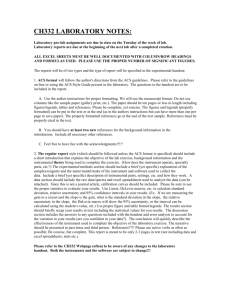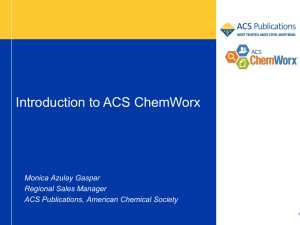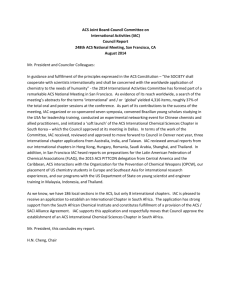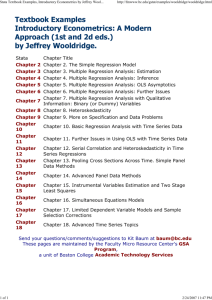review
advertisement
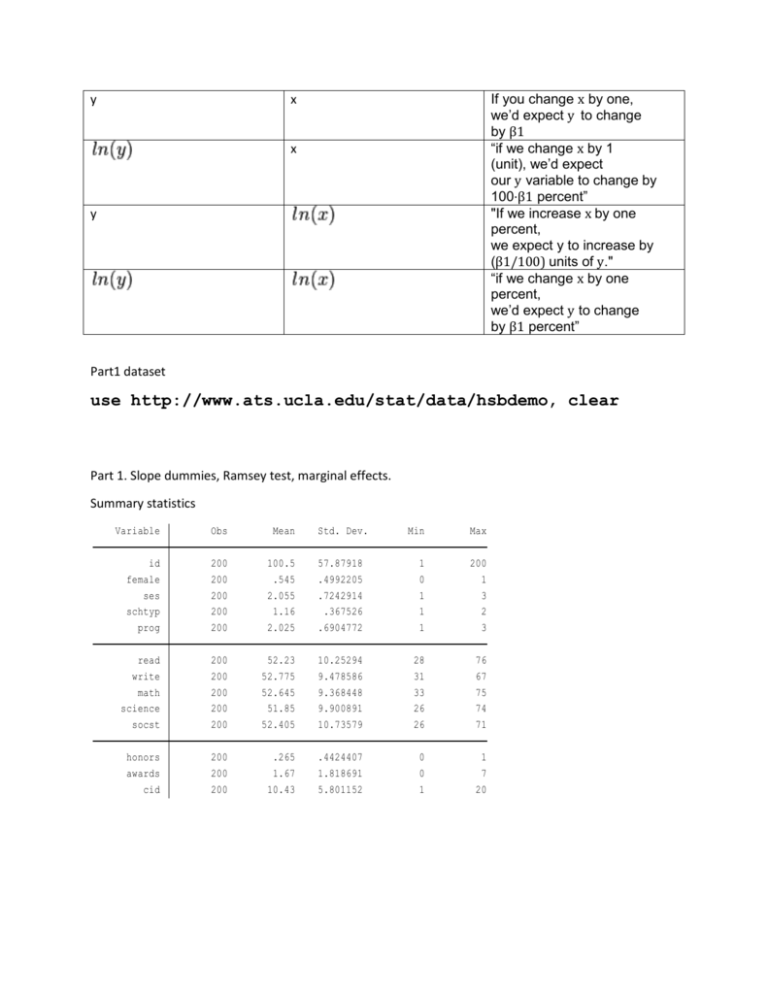
y If you change x by one, we’d expect y to change by β1 “if we change x by 1 (unit), we’d expect our y variable to change by 100⋅β1 percent” "If we increase x by one percent, we expect y to increase by (β1/100) units of y." “if we change x by one percent, we’d expect y to change by β1 percent” x x y Part1 dataset use http://www.ats.ucla.edu/stat/data/hsbdemo, clear Part 1. Slope dummies, Ramsey test, marginal effects. Summary statistics Variable Obs Mean Std. Dev. Min Max id female ses schtyp prog 200 200 200 200 200 100.5 .545 2.055 1.16 2.025 57.87918 .4992205 .7242914 .367526 .6904772 1 0 1 1 1 200 1 3 2 3 read write math science socst 200 200 200 200 200 52.23 52.775 52.645 51.85 52.405 10.25294 9.478586 9.368448 9.900891 10.73579 28 31 33 26 26 76 67 75 74 71 honors awards cid 200 200 200 .265 1.67 10.43 .4424407 1.818691 5.801152 0 0 1 1 7 20 . regress read c.math##c. socst Source SS df MS Model Residual 11424.7622 9494.65783 3 196 3808.25406 48.4421318 Total 20919.42 199 105.122714 Std. Err. Number of obs F( 3, 196) Prob > F R-squared Adj R-squared Root MSE t P>|t| = = = = = = 200 78.61 0.0000 0.5461 0.5392 6.96 read Coef. [95% Conf. Interval] math socst -.1105123 -.2200442 .2916338 .2717539 -0.38 -0.81 0.705 0.419 -.6856552 -.7559812 .4646307 .3158928 c.math#c.socst .0112807 .0052294 2.16 0.032 .0009677 .0215938 _cons 37.84271 14.54521 2.60 0.010 9.157506 66.52792 Remark: reading score, math score, social science score 1. Write out the estimated equation, use e to denote the error term. ̂0 + 𝛽 ̂1 𝑥1 + 𝛽 ̂2 𝑥2 + 𝛽 ̂3 𝑥1 × 𝑥2 + 𝑒 𝑦̂ = 𝛽 2. Is the estimated coefficient significant at 5% level? Use 3 ways to illustrate your result based on the regression table above. You don’t have to write out the critical t value, but say how to display it on Stata. t- value, p-value, 95%CI t-value= display invttail(196,0.025) since it is a two sided test. 3. a. Explain what the coefficient for the interaction here means. The estimated coefficient (effect) of math on reading changes by 0.0112807 if socst increases by 1 unit. b. Given math=50, what is the effect of socst on read i. take derivative of the estimated equation with respect to socst, then, plug in 50 for math. c. Given socst= 30, what is the effect of math on read Here is a Ramsey test of the regression above F(3, 193) = Prob > F = 1.12 0.3432 State the Null for Ramsey and whether you reject at 5% level. H_0: the model has no omitted variables. Note that this is different from the overall test, which has null: b_1=b_2=… =0 y here is “read” Average marginal effects Model VCE : OLS Number of obs = 200 Expression : Linear prediction, predict() ey/ex w.r.t. : math ey/ex math Delta-method Std. Err. .7260325 .059477 z 12.21 P>|z| [95% Conf. Interval] 0.000 .6094598 .8426053 . margins, eyex( math) atmeans Conditional marginal effects Model VCE : OLS Number of obs = 200 Expression : Linear prediction, predict() ey/ex w.r.t. : math at : math = 52.645 (mean) Delta-method ey/ex Std. Err. math .730566 .0592294 z 12.33 P>|z| [95% Conf. Interval] 0.000 .6144786 .8466534 Compare the tables above, what can you conclude about this dataset. To answer this type of question, you should not use words that are affirmative such as must be, should be, definitely, etc. You don’t see the data, or the whole distribution of elasticity. Explain what you see first, and then try to interpret what might be going on. a. Point out the difference between ave elasticity and elasticity at ave. b. The two values are not far away from each other, which indicates there is no tremendous change in the trend of the elasticity. We showed this before ( such as a u shape or wedge shape trend). It might be linear, but we don’t know. c. Note that the margin at ave is slightly higher than the ave margin. This means that there might be more weight in the lower tail of math score distribution. Part2, regression, testing and prediction and forecasting Dataset for part2 use http://www.ats.ucla.edu/stat/stata/webbooks/reg/elemapi2, clear Api00(academic performance in 2000) 1. Complete the table above. Apply the formulas for the most. Note that: this is only true for numerator df =1 for the F. Namely, you only have 1 independent variable. F= t^2 You get t, then std. Err is just t/4.554; because the default testing is whether estimated coefficient is significant. i.e H_0: \beta =0 . regress api00 ell meals yr_rnd mobility acs_k3 acs_46 full emer enroll Source SS df MS Model Residual 6740702.01 1240707.78 9 385 748966.89 3222.61761 Total 7981409.79 394 20257.3852 api00 Coef. ell meals yr_rnd mobility acs_k3 acs_46 full emer enroll _cons -.8600707 -2.948216 -19.88875 -1.301352 1.3187 2.032456 .609715 -.7066192 -.012164 758.9418 Std. Err. .2106317 .1703452 9.258442 .4362053 2.252683 .7983213 .4758205 .6054086 .0167921 62.28601 t -4.08 -17.31 -2.15 -2.98 0.59 2.55 1.28 -1.17 -0.72 12.18 Number of obs F( 9, 385) Prob > F R-squared Adj R-squared Root MSE P>|t| 0.000 0.000 0.032 0.003 0.559 0.011 0.201 0.244 0.469 0.000 = = = = = = 395 232.41 0.0000 0.8446 0.8409 56.768 [95% Conf. Interval] -1.274203 -3.28314 -38.09219 -2.158995 -3.110401 .462841 -.3258169 -1.89694 -.0451798 636.4785 -.4459382 -2.613293 -1.685309 -.4437088 5.747801 3.602071 1.545247 .4837019 .0208517 881.4051 2. Is the overall test significant at 5%? 3. Is each coefficient significant at 5%? Variable Obs Mean Std. Dev. Min Max snum dnum api00 api99 growth 400 400 400 400 400 2866.81 457.735 647.6225 610.2125 37.41 1543.811 184.8231 142.249 147.1363 25.24739 58 41 369 333 -69 6072 796 940 917 134 meals ell yr_rnd mobility acs_k3 400 400 400 399 398 60.315 31.4525 .23 18.25313 19.1608 31.9117 24.83919 .4213595 7.484563 1.368693 0 0 0 2 14 100 91 1 47 25 acs_46 not_hsg hsg some_col col_grad 397 400 400 400 400 29.68514 21.2525 26.015 19.7125 19.6975 3.840784 20.67577 16.33269 11.33694 16.47071 20 0 0 0 0 50 100 100 67 100 grad_sch avg_ed full emer enroll 400 381 400 400 400 8.6375 2.668478 84.55 12.6575 483.465 12.13091 .7637868 14.94979 11.74649 226.4484 0 1 37 0 130 67 4.62 100 59 1570 mealcat collcat 400 400 2.015 2.02 .8194227 .816251 1 1 3 3 4. Calculate beta coefficients for ell and meals Standardized beta = b * sd(x)/sd(y) 5. Note that yr_rnd is a dummy variable indicating whether the person is in year round school. Api00 is the academic performance index. Explain what the estimated coefficient means, and is it significant? 6. Keep others constant, how much change in acs_46 would result one standard deviation change in api00. . set obs 401 obs was 400, now 401 . replace ell = 50 in 401 (1 real change made) . replace meals = 40 in 401 (1 real change made) . replace yr_rnd = 0 in 401 (1 real change made) . replace mobility = 25 in 401 (1 real change made) . replace acs_k3 = 19 in 401 (1 real change made) . replace acs_46 = 30 in 401 (1 real change made) . replace full = 90 in 401 (1 real change made) . replace emer = 8 in 401 (1 real change made) . replace enroll = 300 in 401 (1 real change made) The predicted SE is predicSE 9.977622 Predict what the 95% CI for the x given above Forecast what the 95% CI (you should know how to calculate forecast SE based on the known info) Plug the observation into the estimated equation, get the conditional mean. PredicSE^2 + Root MSE^2 = ForecastSE^2 Then build the CI. 7. If you want to test the coefficient for meals has a negative effect. a. Set up your H0 and Ha b. What is your p-value here c. Do you reject it at 1% significance level. 8. This is your dataset, calculate the OLS 88.00 12 80.00 6 96.00 8 95.00 85.00 91.00 93.00 83.00 90.00 5 7 5 7 6 8



